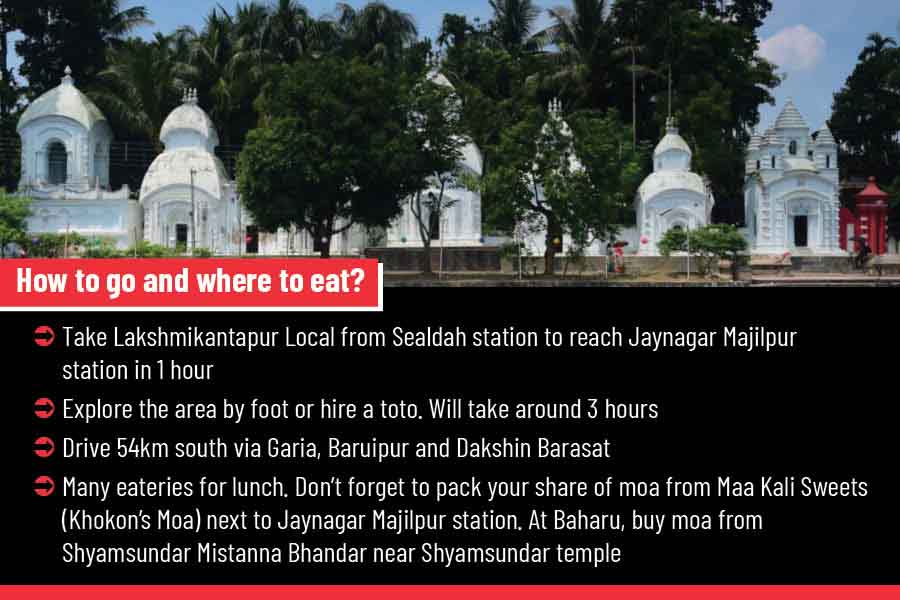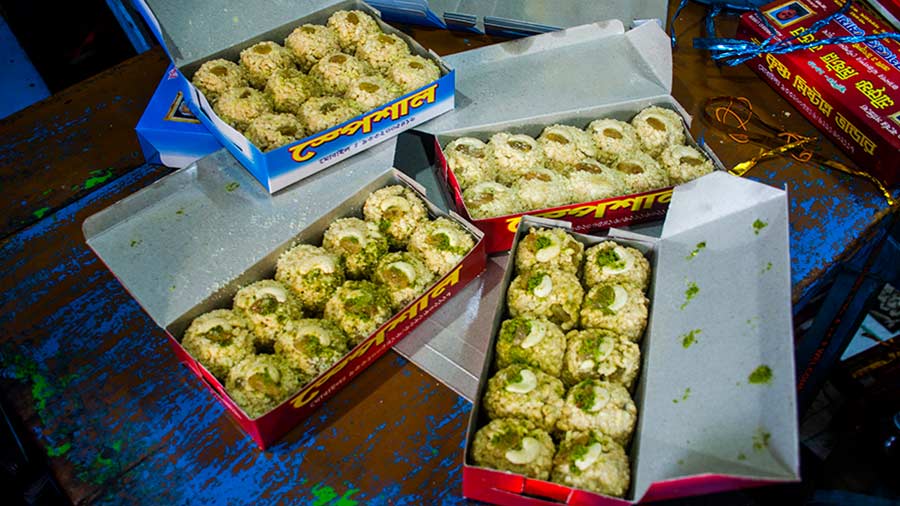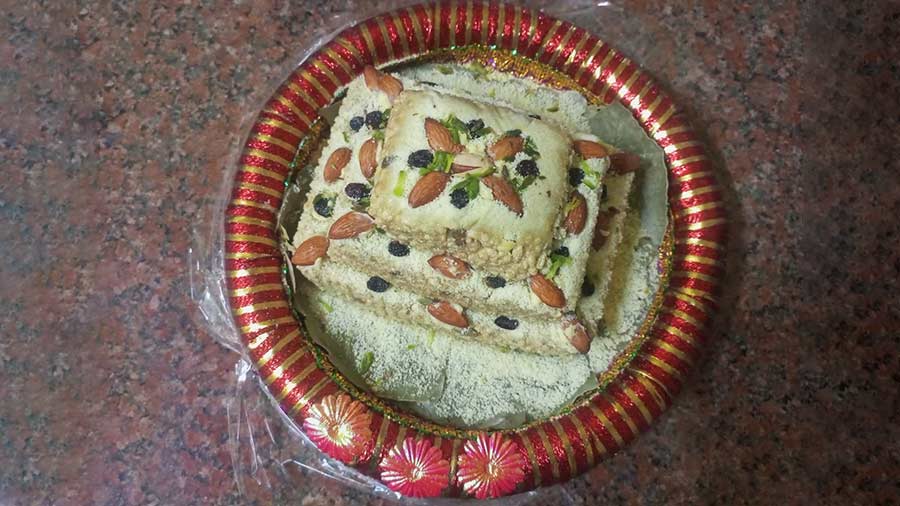The very mention of Jaynagar brings to mind ‘moa’ — the wintry delight of khoi rolled in gur and kheer. The town, now part of the Jaynagar Majilpur Municipality, has a rich history and its ancient mansions and temples stand as mute evidence of a forgotten era.
Early history of Jaynagar Majilpur

Gateway leading to Mitra Para at Jaynagar
Joynagar village finds mention in Raymangal, a Bengali narrative written in 1658 by poet Krishnaram Das of Nimta village. Once the Adi Ganga, a stream that was part of the Hooghly river, once flowed by the village. After it dried up, all that remained were fragmented water bodies. Rennel’s map of 1779 shows its existence as a faint stream.
Binoy Ghosh mentions in his book Paschimbanger Sanskriti (Part 3, 1980) that during the 16th-17th century Joynagar was a part of the Sunderbans. The first prominent individual to visit Joynagar was Gunananda Matilal, a member of the renowned Matilal family, somewhere in the beginning of the 16th century. The family originated from Bikrampur village (now in Bangladesh) and their later descendants settled in the Bowbazar area of Kolkata. Kumadananda, a novel written by scholar Nakuleswar Bhattacharya in 1907, indicates that the Matilal family might have existed in Joynagar much before Gunananda Matilal’s arrival.
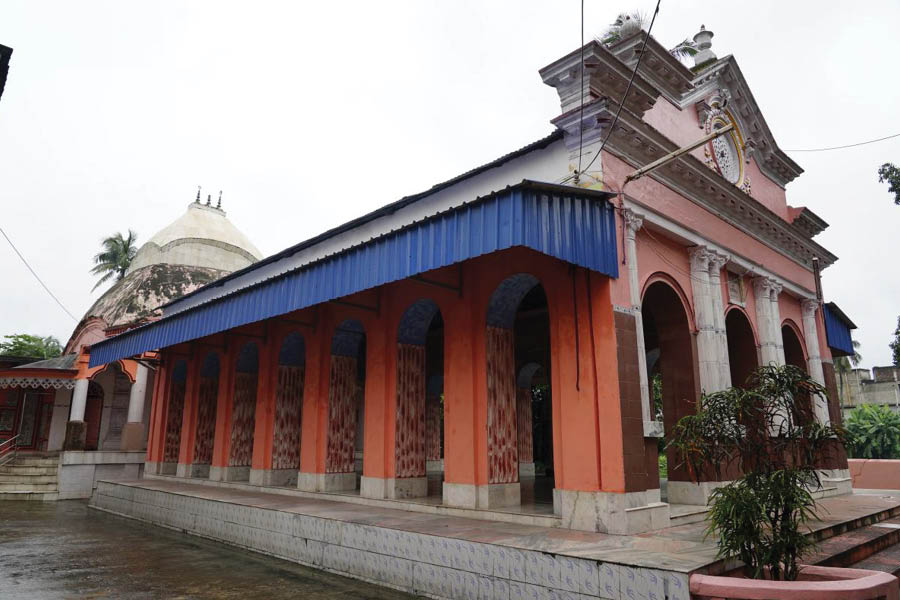
RadhaBallabh temple with Natmandir at Jaynagar
Among other prominent families that later arrived in the Joynagar area was the descendant of the Mitra family from Barisha. Ramgopal Mitra was the first to arrive somewhere between the end of 16th century and beginning of the 17th century.
The earliest renowned settler of Majilpur was Chandraketu Dutta, a kayastha gentleman who arrived around the beginning of the 17th century from Jessore (now in Bangladesh) along with their family priest Srikrishna Udkata and Raghunandan Pota, when King Pratapaditya was defeated by Islam Khan, subhadar of Bengal. Thereafter, the Dutta family prospered at Majilpur. The lineage of Srikrishna Udkata formed the Bhattacharya family which had many famous descendants, including famous social reformer and scholar, Sivanath Shastri. His residence has been declared heritage by the West Bengal Heritage Commission. Renowned freedom fighter Kanailal Bhattacharya hails from this family.
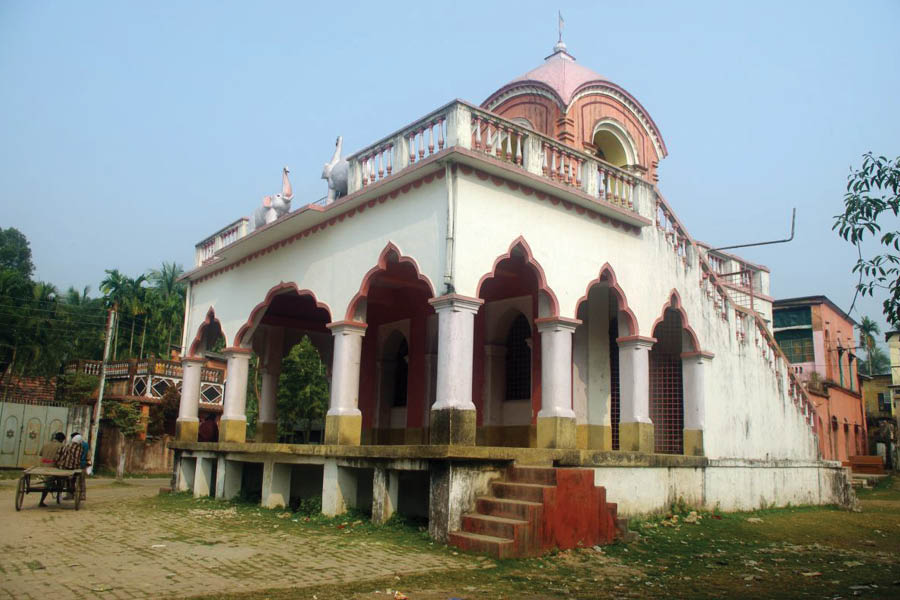
Charchala Dolmancha of RadhaBallabh at Jaynagar
There seems to have been civilisation in this area much earlier as is evident from black and metal sculptures discovered from the area while conducting excavation. Of these, a fragment of a 10th century Bhairava image with two arms has been discovered from this area. At present, it is kept at the State Archaeological Museum in Kolkata’s Behala. There is a small museum named after local archaeologist Kalidas Datta at Majilpur.
A tour of Jaynagar Majilpur
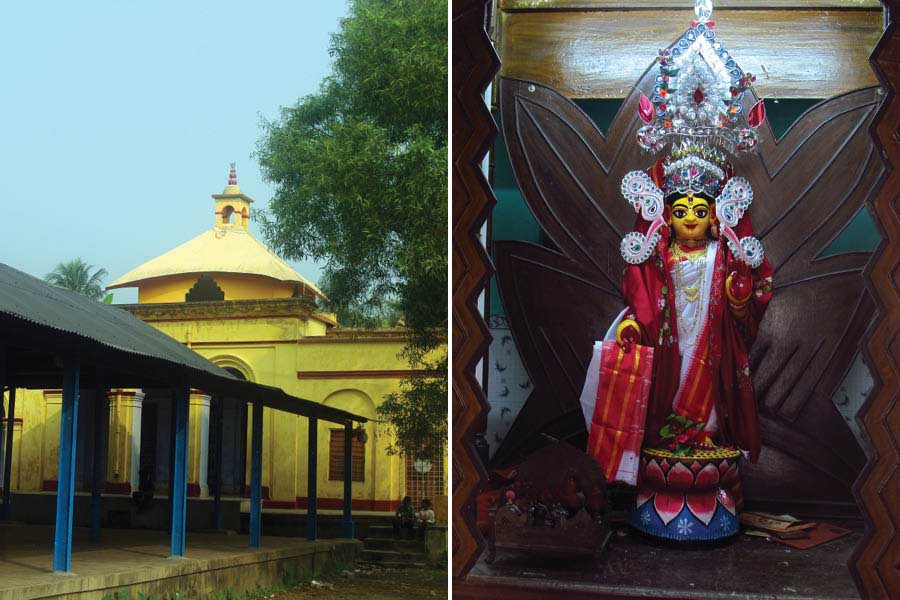
Joychandi idol was established in Jayanagar by Gunananda Matilal
Start your tour of Jaynagar with the Dwadash Shiva temples (group of 12 temples) built by members of the Mitra and Bose families on the banks of a huge waterbody named Mitra Ganga, which once was part of the stream of Adi Ganga. There are the remains of a gate painted in red in the midst of the cluster of 12 temples. All the temples are of aatchala style except one. The two oldest temples of this cluster on either side of the gate were built by Madhusudan Mitra in 1755. At present, only the northern side temple exists. The southern side shrine has been replaced by a Pancharatna-styled temple which was built by Suresh Chandra Mitra in 1922. There are two large dolmanchas on either side of this cluster. Four other aatchala temples also exist in the area. The temples are maintained by the local Mitra Ganga trust committee.
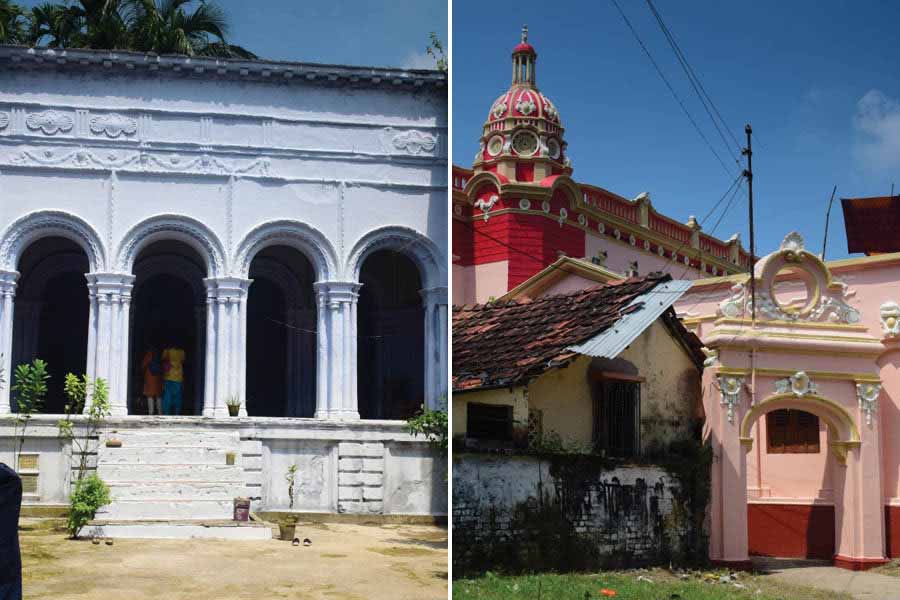
(L)Thakurdalan of Krishna Mohan Mitra, Mitra para, Jaynagar (R) House of Kshetranath Mitra, Mitra para, Jaynagar
Gunananda is credited with building the temple of Joychandi as a result of divine intervention, while he was travelling by waterways during the first half of the 16th century. Jaynagar is believed to have derived its name from the name of this goddess. The flat-roofed temple with a contemporary pinnacle houses the four-feet-high wooden deity at present. The residence of the Matilal family still exists in Joynagar. Durga Puja is still celebrated in their three arched thakur dalan.
Another important structure of Joynagar is the aatchala-styled Radhaballabh temple with a decorated flat-roofed natmandir. There is also a charchala Dolmancha nearby. There is a legend that, around 1600, King Pratapaditya of Jessore brought these deities of Radhaballabh from Khari village of Mathurapur –ii block to Joynagar and built a small temple. However, as per Binoy Ghosh, the temple was built by members of Mitra family. Sagar Chatterjee states that the natmandir was built in 1853 by Krishna Mohan Mitra.

Dhanwantari Kalimata deity, Majilpur Wikimedia Commons, Shobhanlal Mukherjee
A pathway starts from the gateway at Dwadash Shiva temple, which is named after freedom fighter Sachindranath Mitra. It leads to the Joynagar Mitra Para. Here stands the mansion of Krishna Mohan Mitra that houses a five-arched thakur dalan. Durga Puja is held here every year. Further down the road is the beautiful mansion of Kshetranath Mitra who was an art connoisseur.
Other important heritage sites of Joynagar are Ramhari Math, Radha Shyam Sundar Jiu temple and Ghosh Para Mahadev temple.
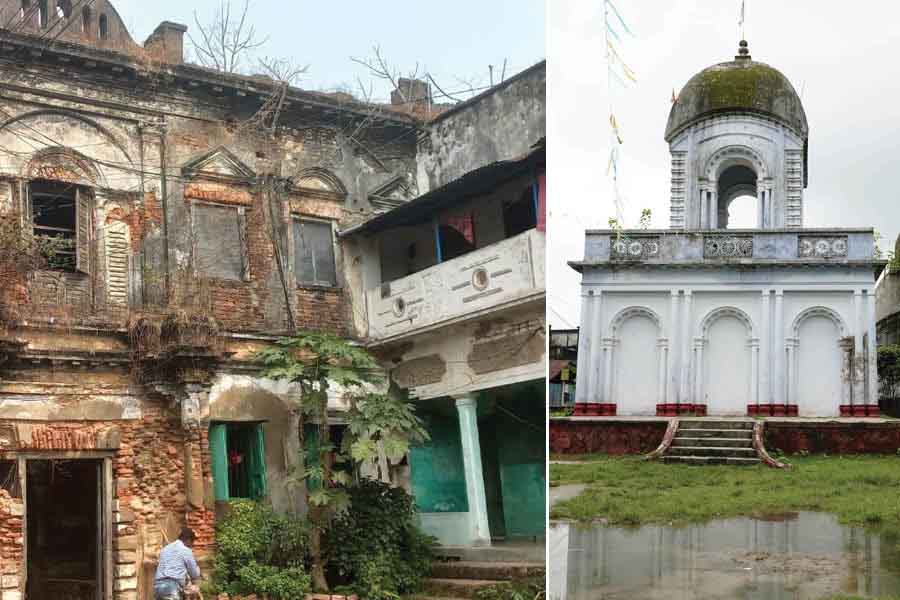
House of Dutta family at Majilpur where Bankim Chandra Chattopadhyay supposed to have visited Sanjay Ghosh
As for Majilpur, the most significant built heritage is the Dhanwantari Kali Mata temple, which was originally constructed during the beginning of the 18th century. Majilpur is famous for its earthen dolls. The tradition of making such dolls began with Manmatha Nath Das, who continued successfully with his nephew Panchugopal Das. At present, the tradition of making Joynagar’s earthen dolls is being carried on by Panchugopal’s son Sambhu Das, who lives in Majilpur’s Bosepara area near the Netaji statue. Earthen dolls are also made by Rabindrantah Das, who stays at Majilpur Mahishyapara.
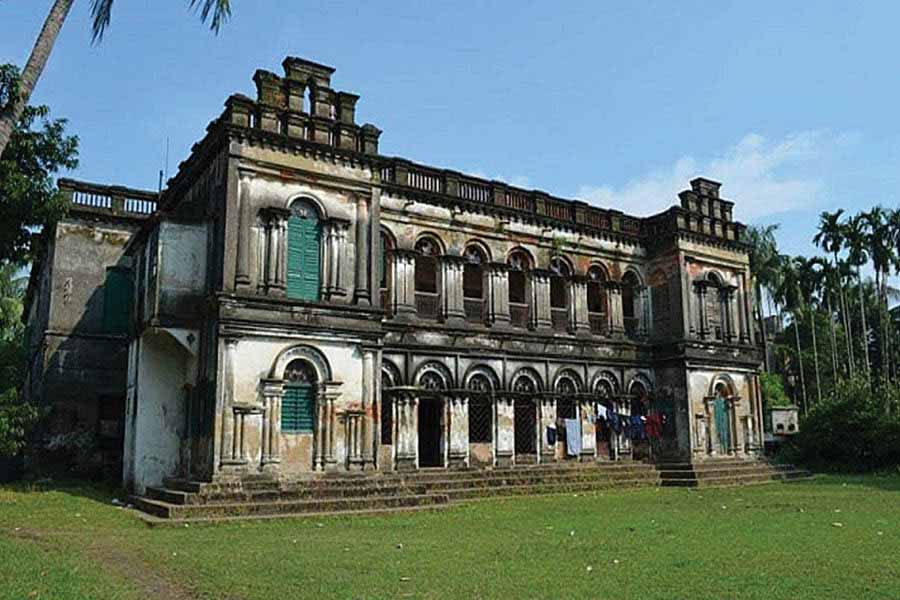
House of Dutta family where "Ghurghutiyar Ghatna" was filmed (now demolished) Wikimedia Commons, Sourav Bapuli
Local researcher Sanjay Ghosh said novelist Bankim Chandra Chattopadhyay visited the household of Ram Chandra Dutta. The interior of the house has a five-pillared thakur dalan and a five-pillared flat-roofed Gopaljiu temple studded with stucco decoration. Nearby, there are two aatchala Shiva temples and a Dol mancha belonging to the Dutta family and the remains of a pillared gate.
In Bhattacharya Para of Majilpur, there are three aatchala-styled Shiva temples. Of these, two were built by descendants of Shri Krishna Udgata, a member of the Bhattacharya families, during the early 19th century. The other temple was built by the Siddhanta family.
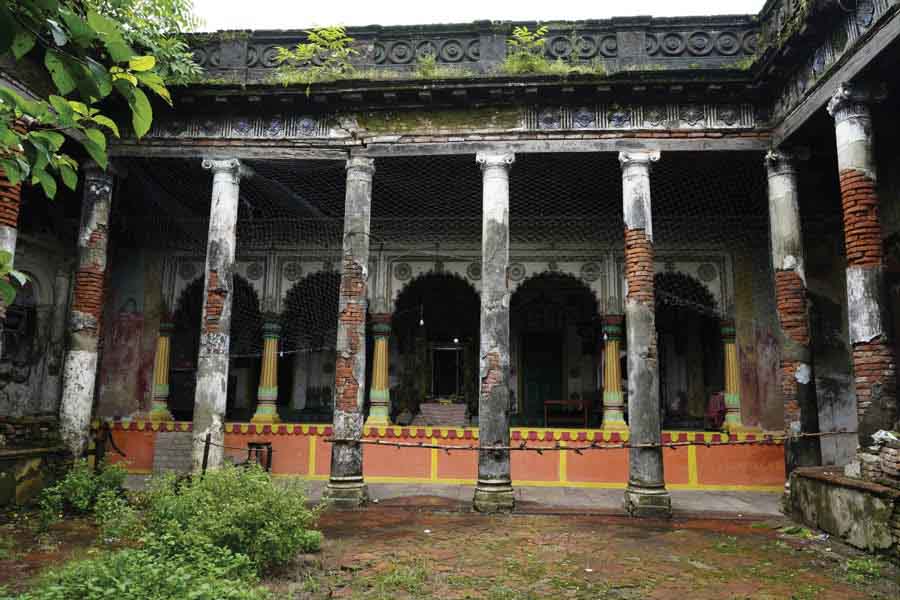
Shyamsundar Jiu flat roofed temple has remains of fresco painting on its interior walls
One of the most impressive built heritages of Majilpur area has been demolished in recent times. This was one of the mansions of the Dutta families, which was famous for being the shooting location of the film Ghurghutiar Ghatana directed by Sandip Ray way back in 1999.
Around 5km north of Joynagar is the village of Baharu, equally famous for being a hub of moa. The Shyam Sundar Jiu flat-roofed temple is worth taking a look at. The temple was built in 1825 by Nandakumar Basu, who imported stones from Chunar and used fresco paint from Jaipur to build and decorate this temple. There are remains of fresco paintings inside the temple, which are fading with each day.
